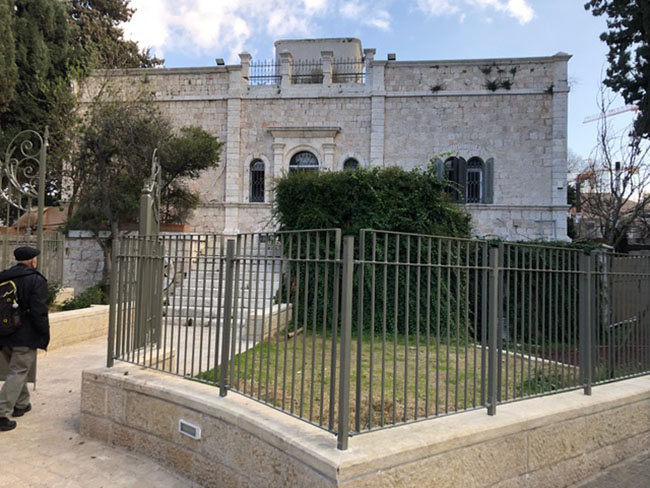
By Steve Kramer
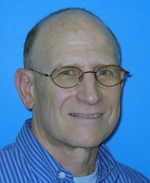 JERUSALEM — Israel is coming back to life slowly. (Unfortunately this doesn’t pertain to air travel, which may be in hiatus until after Passover – but we don’t know anything for sure.) To celebrate coming out of our third lockdown we recently went to Jerusalem for an urban exploration.
JERUSALEM — Israel is coming back to life slowly. (Unfortunately this doesn’t pertain to air travel, which may be in hiatus until after Passover – but we don’t know anything for sure.) To celebrate coming out of our third lockdown we recently went to Jerusalem for an urban exploration.
We drove to our friends’ apartment, only the third time in a year we’ve been to Israel’s capital. Before our tour, we had lunch with Sarah Lynn (formerly of Ventnor, NJ) and her husband Ami, a Persian-born Israeli who once taught at Margate’s Hebrew Academy and later was the rabbi of Binghamton NY’s Orthodox synagogue. Among other things, Ami is a registered guide. He wanted to take us to Hanevi’im Street. We were his “guinea pigs” for leading a tour there.
We took the bus from their Makor Rishon neighborhood to Jaffa Road, the pedestrian thoroughfare which the Light Rail system follows. At the King George St. corner we viewed an old plaque declaring that King George Avenue had been, “Opened by his excellency Sir Herbert Samuel, High Commissioner for Palestine in the presence of Sir Ronald Storrs, Governor Jerusalem – Jaffa district and Ragheb Bey El Nashashibi, mayor of Jerusalem, 9th December 1924.”
Sir Herbert Samuels was the first and only Jewish High Commissioner under the British Mandate for Palestine, which had officially begun two years before in 1922. Samuels was a British peer and an ardent Zionist (many English Jews weren’t) who was a strong proponent for the Jews while in office. Unfortunately, Samuels erred when he appointed the noted Arab nationalist extremist Hajj Amin al-Husseini to be Mufti (religious/secular leader) of Jerusalem. Al-Husseini stoked Arab riots against the Jews during his time as mufti and later allied himself with the Nazis, spending time in Berlin during WWII.
Passing through Davidka Square (named for the fearsomely loud but largely impotent piece of artillery used in the War of Independence), we turned onto Hanevi’im Street, which is known to Israelis as the Street of the Prophets, but also as the street of the consuls (many consulates) and the Street of the Hospitals (many).
We passed by the former English Mission Hospital, built in 1897 by the London Jewish Mission Society, a Christian missionary group. There are many churches and other organizations along the street built purposefully to foster Christian conversion by attending to the needs of Jerusalem’s wretchedly poor Jewish population. Lately this former hospital has been repurposed as a school, a common progression.
During the late 18th century many European powers pressured the declining Ottoman Empire (the “sick man” of Europe) to offer land for their hospitals, schools, and hostels. We passed a forlorn, old and dilapidated building whose front yard was filled with building materials meant for the high rise being constructed next door. Ami explained that many of the once-beautiful, old buildings were being rehabilitated by the developers, a requirement integral for construction approval. This property will probably be part of a public access park before the project is complete.
Below are some of the more prominent landmarks on the street, all repurposed:
The Caspari Center is a modern center for Biblical and Jewish Studies (from a Christian perspective). Some of the nearby buildings include the St. Joseph Convent and School, which was also relocated from the Old City to the “new” city and housed French nuns, and the William Holman Hunt House, built in 1869 by a famous British artist as his residence and studio, which later was the home for sixty years of Dr. Helena Kagan, a pioneering pediatrician. The famous poet Rahel lived in the small house in the courtyard for a time in the 1920s.
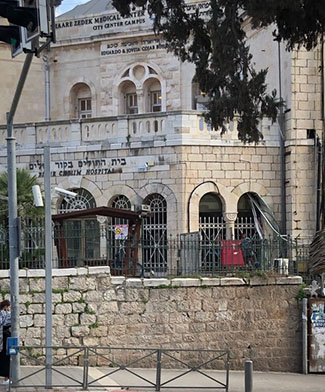
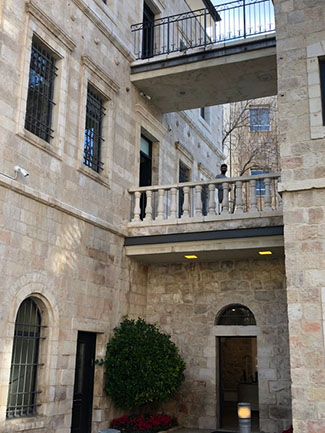
The Bikkur Holim Hospital, which also moved from its Old City location after WWI, was designed by a Christian architect, Conrad Schick, in the Eclectic Style with elements of Neo-classicism, art deco, and modernist styles. Schick, born in Germany, wasn’t an architect by training but he designed and supervised the building of many nineteenth-century buildings in the city. “Schick was not an archaeologist either, but he researched different historical periods, carried out excavations in different locations of the city, and published a large number of articles and archaeological reports. Schick was not trained in making models, [but] he excelled in the production of attractive and accurate models of monuments in Jerusalem. And though he was not a geographer, he documented the city through maps. It could be said that on the whole Conrad Schick embodied the sum of imminent European concerns in Jerusalem in the second half of the nineteenth century, typifying the different historical and social sciences in combination with an unequivocally unique personality.”
The fantastic, beautiful Optical Center Foundation is appropriately located on the site of the former Institute for the Blind. It is a center for eye research and treatment, with a small, interesting and informative lobby. It was restored by French-Jewish businessman Laurent Levy, who founded the international Optical Center chain that sells visual and auditory aids. Levy also built the beautiful Hebrew Music Museum complex in the Nahalat Sheva neighborhood of Jerusalem.
The Marienstift Children’s Hospital occupied another late 19th century building. Its location now houses the Israeli Society for Pediatric Surgery. The Bishop’s House, built in 1876, was once the residence of the director of the London Society for Promoting Christianity Among the Jews. Today a large residential complex is located on its premises and the house is the aesthetic, historical and required part of the project.
The Ethiopian Consulate was built in 1924 at the initiative of Empress Zaudito, a devout Christian. (The Ethiopian Christian community is one of the oldest in the world.) It has about 90 rooms and the exterior features porcelain decorations with a lion, the symbol of the royal family, alongside of an inscription proclaiming, “The lion of Judah is victorious.”
Next to the Consulate is the ORT School, which was built on the site of the luxurious but temporary encampment built by the Ottomans for the visit of the German Kaiser in 1898. (Theodor Herzl briefly met the monarch during the visit, a meeting that didn’t prove helpful to the Zionist cause.) After the Kaiser’s departure, the German Lutheran church built the Probstei, the home of the Lutheran Probst (head of the congregation). The structure still remains and is now part of a campus for ORT, the global educational network driven by Jewish values.
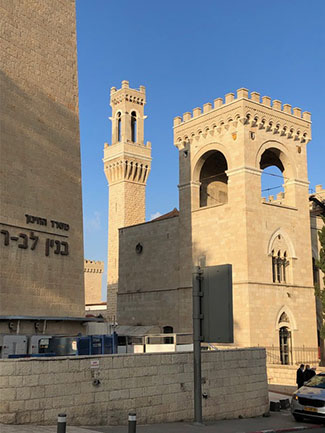
Perhaps the most outstanding sight along Hanevi’im Street is the Italian Hospital, especially when viewed in juxtaposition to the huge, curved Ministry of Education office building next door. Built in the second decade of the 20th century, the Italian Hospital resembles Florence’s Medici family palace, known as the Palazzo Vecchio. An imposing bell tower stands behind the church in the center of the compound. The hospital was built to be an Italian foothold beyond the Old City. During the War of Independence, IDF forces controlled the site, using the bell tower as an excellent observation post. The compound is now part of the Ministry of Education and Culture. We ended our tour in the picturesque Musrara neighborhood, one of the first built outside of the Old City walls.
You should know that my description is only a partial listing of the interesting buildings on or adjacent to Hanevi’im Street. Our friend Ami did a great job of describing the buildings and the culture of the street.
Besides the well known tours of the Old City, there are many more tours to explore the city outside of the Old City walls. When visiting Jerusalem for the first time, visitors should allow at least four or five days to get a feel for this amazing city.
(I’m indebted to Yad Ben-Zvi’s “Jerusalem – a walk through time” for some of the descriptions in this article.)
*
Steve Kramer is a freelance writer based in Kfar Saba, Israel. He may be contacted via steve.kramer@sdjewishworld.com